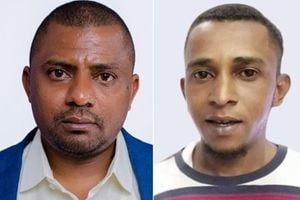Breaking News: Former Lugari MP Cyrus Jirongo dies in a road crash

The abduction of President Ruto’s critics echoes the activities of Uganda’s State Research Bureau, the shadowy unit that was charged with kidnapping Idi Amin’s imagined enemies.
In 1975, Nyandarua North MP JM Kariuki was lured out of Hilton Hotel and murdered – a tragic end to a populist politician who had dared criticise the government. JM, as he was known, had stepped on many toes, making enemies with a system that brooked no dissent. Despite the outrage, police denied any involvement, and no meaningful inquiry was opened into his disappearance and killing.
It is widely acknowledged that JM left Hilton in the company of Ben Gethi, the then-General Service Unit commandant. Yet orchestrated police cover-ups ensured the trail went cold. Half a century later, as abductions and disappearances of government critics persist, Inspector-General of Police Douglas Kanja refutes the existence of shadowy Gestapo-like units accused of kidnapping, torturing and silencing dissenters. However, a glance at the 135-year history of Kenya’s police force reveals a legacy intertwined with clandestine operations – a tradition that has come to define the institution.
Mr Kanja may feign ignorance, but Kenya’s policing history is inseparable from that of extra-judicial killer squads, either operating within the force or as what historians call “violent intermediaries.”
The institution has evolved into a profession steeped in hyper-masculinity, ego and the aggressive posturing of “macho men,” often applied with deadly consequences.
The roots of this systemic violence stretch to 1888, when Sir William Mackinnon’s Imperial British East Africa (IBEA) Company received a royal charter to administer the territory that would later become Kenya. IBEA askaris – locally recruited police – were tasked with protecting administrative posts, forts and trade caravans. Their first interior fort was established in Machakos, a town that could have become Kenya’s capital had John Ainsworth – the IBEA administrator – not been ordered to develop Nairobi as a railway hub.
Fort Smith Dagoretti became infamous for one of the earliest recorded abductions in colonial Kenya. It was here that Capt William Purkis of the IBEA orchestrated the capture of Waiyaki wa Hinga, a Kikuyu leader who had resisted the intrusion of his territory and the harassment of his people. Wounded and shackled, Waiyaki died en route to exile in the Coast – a tactic meant to crush anti-IBEA resistance.
When the IBEA went bankrupt in 1895 as the construction of the railway was underway, its askaris were absorbed into the British Protectorate. Yet, the modus operandi of abduction, violence and exile endured.
Richard Meinertzhagen’s chilling memoir, Kenya Diary 1902-1906, provides a firsthand account of his exploits as a leader of colonial repression. The preface to the 1983 edition, penned by Elspeth Huxley, does not shy away from branding Meinertzhagen a killer.
“He killed abundantly and killed for pleasure,” Huxley writes, laying bare the depravity of a man who unleashed terror in the name of Pax Britannica.
Meinertzhagen’s name is inextricably linked to the killing of Nandi laibon Koitalel arap Samoei, a resistance leader whose death marked a blow to the Nandi community. Fuelled by an “unashamed bloodlust,” Meinertzhagen exemplified the machinery that expanded and safeguarded the British Empire – an empire built on a foundation of brutality and oppression.
Colonial administration
In 1906, the Kenya Police was legally constituted via a Police Ordinance and became the unit that would protect the colonial administration from critics. Any person deemed be anti-settlers was banished. That is what befell Chebochok Kiptonui arap Boiso, a leader of the Talai people. He was wrenched from his community and exiled to Nyeri in 1912 – a move by the colonial administration to stifle his influence. His place of exile, near present-day Kagumo High School, came to be known as Kirichu, a distorted echo of the name Kericho, preserved in his memory.
It was Harry Thuku’s turn a decade later. Founder of Kenya’s first political party, Thuku was exiled without trial from 1922 to 1930. His banishment incited what the colonial government euphemistically termed “disturbance”.
It was a grim chapter of violent suppression, as askaris gunned down protesters demanding Thuku’s release. If such scenes feel eerily familiar, it is because the brutal tradition of police killing protesters predates the regimes of Jomo Kenyatta, Daniel arap Moi, Mwai Kibaki, Uhuru Kenyatta and William Ruto. The practice has become entrenched in the police force DNA.
Winston Churchill, a figure of imperial authority, justified this tyranny by invoking the Removal of Natives Ordinance. He argued that it sanctioned the deportation of anyone deemed a threat to peace.
“In a country where there is a large and primitive native population, some provision of the kind is required,” Churchill declared, brushing aside the principles of justice.
He further rationalised impunity by claiming that requiring an ordinary trial would undermine the efficacy of the Ordinance in curbing seditious or violent tendencies.
In 1922, Barsirian arap Manyei, the rightful successor to Koitalel arap Samoei, was abducted from his community and exiled to Meru for many years for resisting the annexation of his territory. His ordeal marked him as one Kenya’s longest-serving political prisoners.
During the turbulent 1950s, the British colonial police wielded emergency powers with ruthless efficiency, orchestrating one of the most expansive crackdowns in the history of the empire. Dissenters and critics were silenced with chilling finality – killed or exiled without trial. It was against this backdrop of the Mau Mau uprising that extra-judicial killings became not just common, but a hallmark of imperial preservation.
To suppress the rebellion, the colonial regime unleashed elite killer squads under Special Branch, led by John Prendergast, and Special Tribal Police (known as Home Guards) embodying the darkest depths of state-sanctioned violence. The Special Tribal Police was devolution of violence. By 1956, an estimated 11,000 had been killed. Among the architects of this machinery was Ian Henderson, later infamously dubbed the Butcher of Bahrain. Henderson’s sinister ingenuity lay in his orchestration of “Pseudo-Gangs” – a diabolical strategy that blurred the lines between insurgent and oppressor.
These covert units infiltrated Mau Mau networks, spreading fear and disarray.
The spectre of the Special Branch casts a long and enduring shadow over Kenya’s political landscape, its memory etched indelibly into the minds of those who dared cross its path. Emerging from the colonial state’s apparatus of suppression, the post-independence government merely rebranded this machinery of fear, birthing clandestine formations with carte blanche to operate beyond the law.
Elements like Patrick Shaw, the notorious Kenya Police Reservist who carried out extra-judicial killings with ease, come to mind.
By the 1970s, a covert unit dubbed Ngoroko surfaced, ostensibly as a counter-insurgency force but whispered to be a tool of political assassination. Attorney-General Charles Njonjo would later claim that Ngoroko aimed to eliminate allies of Moi, then poised to succeed Jomo Kenyatta.
Corridors of power
Paranoia gripped the corridors of power, fueling suspicions that the nascent Anti-Stock Theft Unit served as a smokescreen for political repression.
From Jomo Kenyatta to Moi, Kibaki to Uhuru, and now under Ruto, a chilling pattern persists: extra-judicial killings executed with impunity, often orchestrated by faceless squads untethered from the law.
These shadowy outfits – whether the infamous Flying Squad or the bizarre case of Artur Magaryan and Artur Sargasyan, inexplicably elevated to police inspector ranks – embody the covert mechanisms of the government for silencing dissent.
The abduction of President Ruto’s critics echoes the activities of Uganda’s State Research Bureau, the shadowy unit that was charged with kidnapping Idi Amin’s imagined enemies.
Such incidents reveal the enduring nature of coercion and violence in Kenya’s policing history. From the colonial abductions of Waiyaki and Talai leaders to the cold-blooded elimination of modern-day dissenters, the system remains mired in a legacy of brutality and impunity. It is a history that continues for 135 years.
Final Word: If Douglas Kanja remains oblivious to the abductions and persists in issuing statements absolving police, then it’s time for him to confront the truth: he is incapable of providing the security Kenyans deserve.
The honourable course of action would be to step aside and go home.













